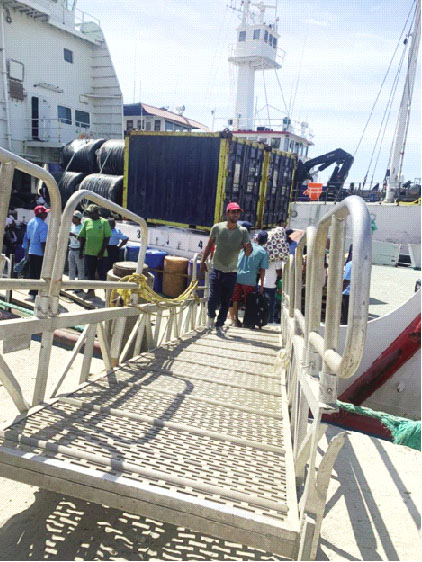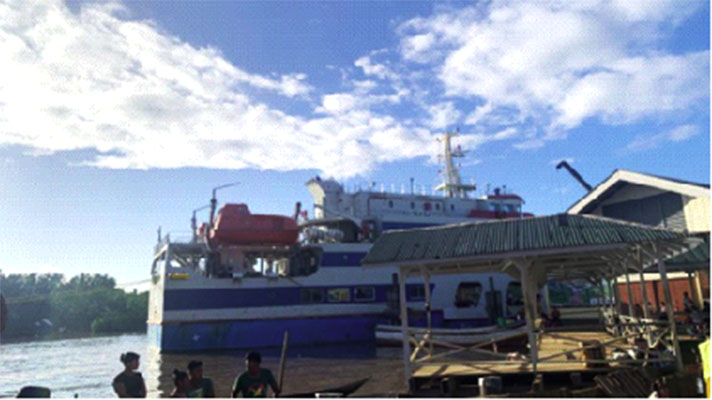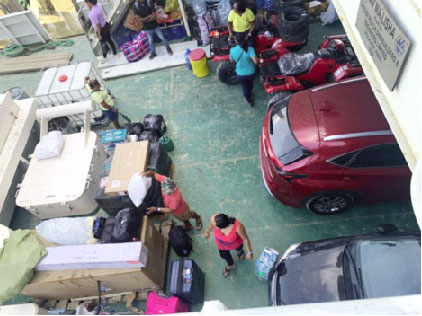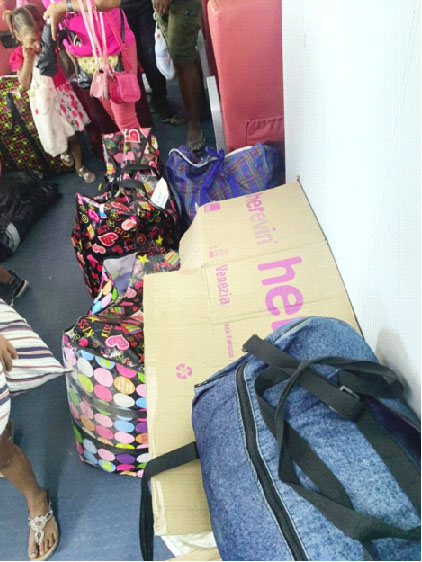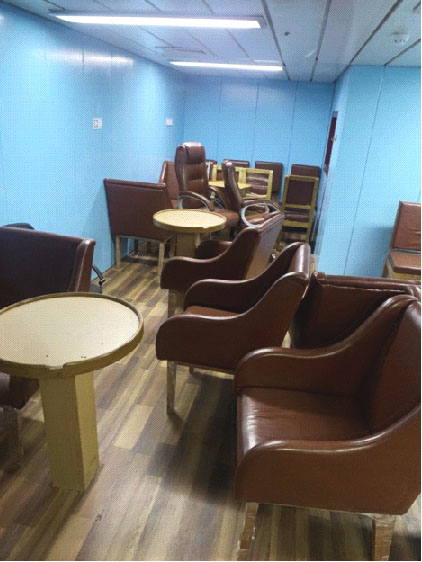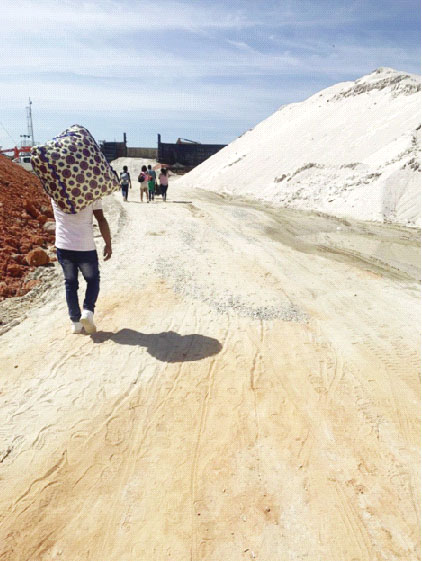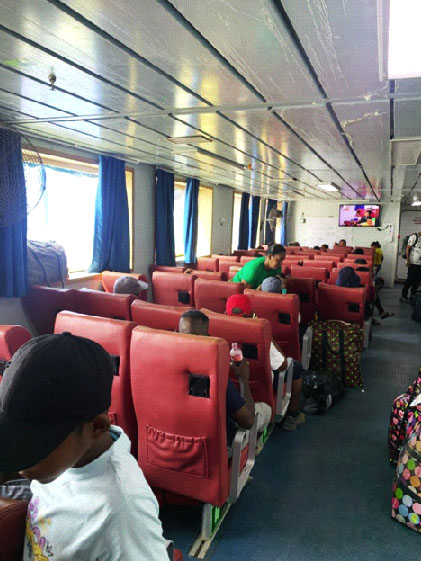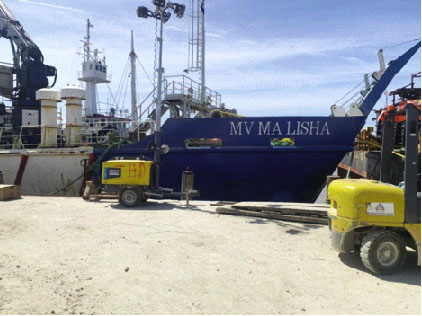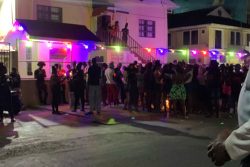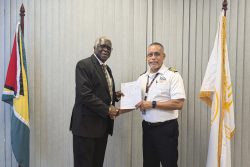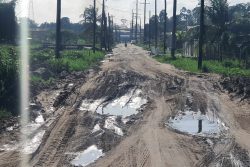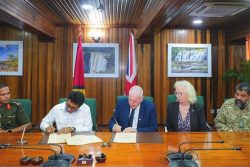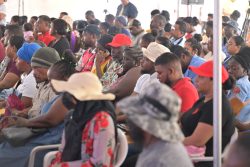The MV Ma Lisha’s voyage from Georgetown to Kumaka, a trek through Guyana’s often wild northwest coastline, is not for the faint-hearted. A 15-hour journey of both physical and emotional highs and lows, it promises exhilarating waves, a rocking boat, and an unforgettable experience for anyone willing to endure the ride. The ship, a massive steel behemoth, cuts through the waves with a deep, rumbling sound as it churns the sea beneath it, lurching in rhythm with the unpredictable sway of the water. The rocking, at first gentle, slowly escalates as the hours go on, and soon even the most seasoned passengers find themselves clutching the edges of their seats.
The journey began smoothly enough, with passengers registering online for their tickets. Options to pay either in person or through MMG (Mobile Money Guyana) made the process efficient and stress-free. It should be noted that a normal seat on the boat is $3000 and a cabin option is $15,000.
As the time approached for departure, the wharf at Georgetown grew increasingly bustling with activity. The air was thick with the scent of diesel fuel and the sound of workers shouting to each other over the growing hum of engines. Vendors, their goods piled high, set up their stations along the pier, while longshoremen hurried to load the cargo on board. There were bags of rice and sugar, securely wrapped, and towering stacks of boxes—many filled with the essentials of life for those who lived on the other side of the journey. After receiving a wristband, and paying a small fee of $300 per parcel passengers were asked to walk through BK compound to board the ferry.
For the shippers, there was a clear order in the madness as each category was loaded on its specific day: furniture, freezers, stoves, and other appliances were loaded first, followed by sacks of flour, salt, and feed. Onboard, passengers watched as men and young boys, no older than ten alike, hustled to carry bags for a small fee. Their faces were streaked with dirt, and their feet pounded against the sandy pathway as they worked quickly and efficiently.
The boat had two floors of seats, and rows of cushioned chairs. On each floor, the air conditioning worked tirelessly, a quiet hum of machinery providing a cool respite from the thick heat. The temperature, at times, seemed to hang heavy, and stifling, but once inside, the cool blast of the AC was a welcome relief. The seats, although practical, were not the most comfortable, and it wasn’t long before passengers began to shift uncomfortably, looking for any space they could claim for sleep. After all, with the boat’s tendency to rock violently with each wave, finding comfort became secondary to simply holding on.
The crew, pleasant and professional, ensured the process of boarding and settling in was as smooth as possible, distributing cabin keys promptly. A water dispenser was strategically placed at the Transport and Harbours location on Water Street for passengers to quench their thirst, with ice readily available. But the sea was no respecter of schedules. Before long, the once-calm waters began to churn and roll, and the boat started to sway gently at first. It was a subtle motion at first, hardly noticeable for the first few hours. But as the evening deepened, the swaying became more pronounced. The boat groaned and hummed steadily under the strain of the waves, rocking side to side, back and forth, with the ocean seemingly pushing it further off course with each passing minute. The soft rustling of passengers turning in their seats, trying to adjust to the steady motion, turned into the occasional sigh and the soft sound of bodies shifting uncomfortably.
The boat’s canteen remained open for as long as they could, its small kitchen offering hot meals and snacks, though the food was often eaten hurriedly, with passengers trying to steady their containers as the boat rocked. The kitchen staff, who were surprisingly cheerful despite the relentless waves, said their working hours often depended on how well the boat weathered the waves. Some nights, they’d be busy until the very last passenger had eaten, while other times, they’d wrap things up early. Despite the challenges, the canteen staff made sure to offer food that was both reasonably priced and tasty—still, the endless sway made eating a challenge for many.
It wasn’t just the motion of the boat that caused discomfort, but also the lack of sleep for many passengers. With the boat pitching and rolling, those lucky enough to grab a seat would find it increasingly difficult to settle into a restful position. Others, desperate for any bit of comfort, were forced to sleep on the floor, curling up in blankets or lying along the carpeted aisles as the boat continued its bumpy journey through the night. The sound of the waves crashing against the sides of the ship, combined with the occasional groan of the hull, created an atmosphere of uncertainty, as though the very sea had its own plan for the ship. However, for many of the seasoned travellers, this was an all too familiar experience that did not hamper their sleep.
Still, some passengers remained calm, stoic even, content to endure the discomfort. In the cramped hallways and cabins, there was a shared understanding: this was the price of travel to Kumaka. And despite the lack of proper sleeping arrangements, there was a sense of unity in this struggle—this boat, rocking and rolling along the waves, was the only lifeline to Kumaka, and that fact alone kept many going.
The toilets on board, while not luxurious, were an unexpected relief. Running water, with sinks and toilets functioning, was welcomed and appreciated on long-haul boats like this. However, on this journey, there was an unexpected challenge—some passengers within the cabins had clogged the system by discarding toilet paper and, believe it or not, KFC wrappers. It was a reminder of the chaos that can accompany life in transit. But even so, the boat continued its journey, determined and relentless.
As dawn broke and the boat finally approached Kumaka around 6am, it was clear that the journey, though long and being various degrees of comfortable, had its share of rewards. The port of Kumaka was a whirlwind of activity, with small boats and large trucks arriving to unload their goods. Gas tanks, tires, stoves, and TVs were hauled off after the passengers who were eager to set foot on solid ground after the rocky ride. Yet, despite the long hours, the exhaustion, and the unsettling motion, there was a sense of pride. The boat had done its job, and the goods that arrived from Georgetown, as well as the passengers, would now help sustain the community.
One thing is clear: the India-financed MV Ma Lisha is not just a boat. It is a lifeline, an essential thread weaving together the fabric of Kumaka’s daily life. But its journey is more than just a ride—it is a reminder of the ever-present struggle for better infrastructure, more reliable resources, and the resilience required to live in one of the most remote regions of Guyana.
